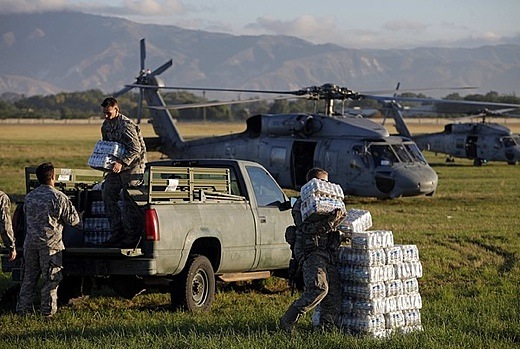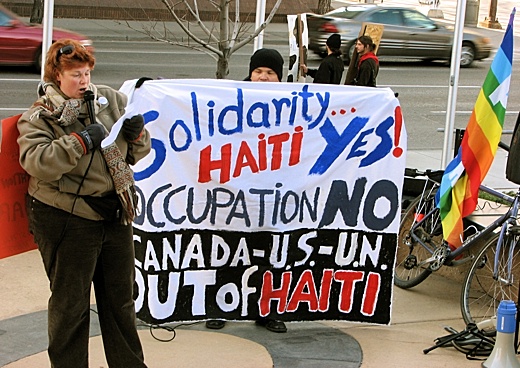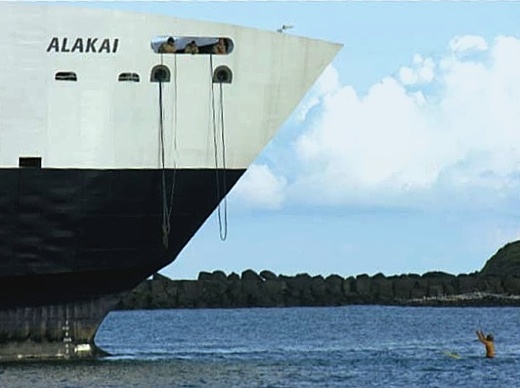SUBHEAD: Washington’s principal concerns have been maintaining order and preventing Haitians fleeing the oppressive conditions of their homeland from reaching US shores.
By Bill Van Auken on 16 January 2010 in WSWS
(
http://www.wsws.org/articles/2010/jan2010/hait-j16.shtml)
 Image above: U.S. troops with the 82nd Airborne Division stack water supplies at Port-au-Prince airport. From (http://www.latimes.com/news/nation-and-world/la-fg-haiti-quake17-2010jan17,0,3017051.story)
Image above: U.S. troops with the 82nd Airborne Division stack water supplies at Port-au-Prince airport. From (http://www.latimes.com/news/nation-and-world/la-fg-haiti-quake17-2010jan17,0,3017051.story)
The first contingents of a US military force expected to reach 10,000 troops arrived in Haiti as anger mounted over the failure of international aid to reach the millions left injured, homeless and destitute by Tuesday’s earthquake.
There were reports of looting and Port-au-Prince residents creating street barricades with the bodies of the dead to protest the lack of assistance. Thousands upon thousands of corpses line streets and are piled up outside hospitals and morgues.
Haitian officials reported Friday that 40,000 bodies have already been buried, many of them in common landfill-style mass graves. They estimate that there are 100,000 corpses still to be recovered. In some areas the number of dead is so overwhelming that bodies have been piled up and burned.
Haitian Health Minister Alex Larsen said the death toll from the January 12 earthquake would climb to half a million, with another 250,000 injured.
More than 300 combat-equipped paratroopers from the 82nd Airborne Division landed at the Port-au-Prince airport from Fort Bragg, North Carolina Thursday night, and a US naval flotilla led by the nuclear-powered aircraft carrier USS Carl Vinson arrived off the coast on Friday.
The paratroopers, the advance guard of a force of about 3,000, are to be joined by some 2,000 marines from the 22nd Marine Expeditionary Unit based in Camp Lejeune, North Carolina. Brought in on the amphibious landing ship, the USS Bataan, the Marines will remain at the ready in Port-au-Prince harbor to be called in if needed to deal with social unrest.
US Joint Chiefs of Staff Chairman Gen. Mike Mullen said that even more than 10,000 US troops would be deployed in the ravaged Caribbean nation if required.
For the estimated 3 million people affected by the earthquake, conditions are growing increasingly desperate. They are unable to find adequate food or water; medical care is rudimentary or non-existent; and electrical power and telephone communications remain down.
Correspondents in the Haitian capital Friday reported little if any sign that aid had reached the population.
At least 300,000 people have been rendered homeless as structures of every kind collapsed in the magnitude 7.0 quake, which struck Port-au-Prince and the surrounding area with a force equal to 500,000 tons of TNT, or 25 times that of the atomic bomb dropped on Hiroshima.
While such a catastrophic event would have inflicted enormous damage anywhere, the effects in Haiti are multiplied by the pre-existing conditions of intense poverty and economic backwardness, the product of a century of imperialist oppression primarily at the hands of Washington.
With time running out for many of the earthquake’s victims, both those trapped in the rubble and those who have suffered internal injuries, multiple fractures and severe wounds that are going untreated, the so-called bottle neck impeding the flow of aid amounts to a death sentence.
“People are without water; children are without food and without shelter,” Ian Rodgers, a senior adviser to Save the Children told the CNN cable news network. “What we will see with the lack of water is the possibility of diarrheal diseases and, of course, that can kill children in a matter of hours if not tended to appropriately.”
“It is very possible,” Rodgers added, “that the situation can go from dire to absolutely catastrophic if we don’t get enough food and medicine and work with children and their families to help them.”
In other words, hundreds of thousands more who survived the initial destruction may die from injuries and disease.
The lack of adequate infrastructure in terms of airports, roads and port facilities to bring in supplies, together with the virtual absence of any government presence coordinating rescue operations are the result not just of Tuesday’s natural disaster. Nor are they—as US Defense Secretary Robert Gates described them Friday—merely “facts of life.”
Rather, they are a manifestation of the enforced backwardness to which Haiti has been condemned by the major banks and corporations represented by the US government and the international finance agencies. Their sole interest in Haiti has been a predatory one, based on the ability to make profits off of near-starvation wages. Together they have systematically undermined the Haitian government ever since the 1986 mass upheavals that brought an end to the three decades of US-backed dictatorship by the Duvaliers.
The president first elected in the wake of the dictatorship, Jean-Bertrand Aristide, was overthrown in US-backed coups not once, but twice—in 1991 and 2004. Meanwhile, Washington and the lending agencies pushed through one round of privatizations after another, stripping the Haitian state of any real power or resources.
Even in the best of times, essential services in Haiti such as health care, housing, transportation, communications, electricity, water and sewerage are grossly inadequate and tenuous.
Rather than developing the country’s infrastructure or ameliorating its desperate poverty, Washington’s principal concerns have been maintaining order and preventing Haitians fleeing the oppressive conditions of their homeland from reaching US shores.
The present intervention being mounted by the Obama administration and the Pentagon is based on similar motives. It is also driven by Washington’s stepped-up efforts to assert its dominance in the hemisphere, expressed in recent months in the right-wing military coup in Honduras and the agreement to set up US military bases in Colombia.
The deployment of troops has taken priority over the distribution of aid. As the Miami Herald reported Friday, “US air-cargo traffic was grounded to give the military airlift priority to bring moving equipment and the first 100 of a planned 900-paratrooper deployment of the 82nd Airborne Division from North Carolina.”
UNICEF, which has massed relief supplies in Panama, sent a plane full of medical kits, blankets and tents, but was denied permission to land and forced to return to Panama.
Initial rescue operations were noticeably focused on aiding US citizens and other foreign nationals. Search and rescue teams brought in from the US and France focused their initial efforts on the flattened four-star Hotel Montana, a watering hole for the Haitian ruling elite and foreign visitors, and the United Nations peacekeeping mission’s headquarters. Haitians were left to dig for their loved-ones and neighbors using their bare hands and pieces of rubble.
The first to be evacuated from the damaged Port-au-Prince airport, which has been taken over by American military controllers, were US citizens.
Haitians are conscious that the lives of foreigners are given more value than their own. “They were furious, though not surprised, that they were left to themselves to dig out the trapped, haul off the dead, beg for help for the dying,” reported the Los Angeles Times.
There are increasing reports of anger among the earthquake’s survivors over the delay in aid. Gunfire has also been reported, along with looting by young men armed with machetes. International officials warn that the longer the situation continues, the greater the chances it will turn into mass revolt.
“Unfortunately, they’re slowly getting more angry and impatient,” said David Wimhurst, spokesman for the Brazilian-led United Nations peacekeeping mission. “I fear we’re all aware that the situation is getting more tense as the poorest people who need so much are waiting for deliveries. I think tempers might be frayed.”
Kim Boldue, the acting chief of the UN Mission, said that “the risk of having social unrest very soon” made it imperative that relief supplies begin arriving.
The real attitude of US imperialism toward the Haitian people found expression in an article posted by Time magazine and entitled, “Will Criminal Gangs Take Control in Haiti’s Chaos?” The article declared, “As Haitian and international officials try to coordinate an effective response to what is probably the worst disaster to ever hit the western hemisphere’s poorest country, they’ll need to be mindful of the human rats that come out of the capital’s woodwork at times like these.”
The article went on to warn that “criminal bands from poor neighborhoods like Cité Soleil and La Saline are almost certain to try to exploit the security void.” It quoted Roberto Perito, described as an expert on Haitian gangs at the Institute of Peace, a government-funded agency with close ties to US intelligence and the Pentagon, saying that the supposed threat is “surely why the US military deployment is adding a security component.”
Time added: “The US military has had its share of experience with Port-au-Prince’s gangs,” noting that they are often “political in nature,” coalescing, as Perito put it, “around charismatic and ruthless Robin Hood figures.”
There is every likelihood that the US military deployment will be turned against the people of Haiti in the suppression of mass unrest. Having occupied the country for 20 years in the first part of the 20th century and intervened twice more in 1994 and 2004, the US military is once again assuming control in what senior commanders say will be a long-term operation.
. 






